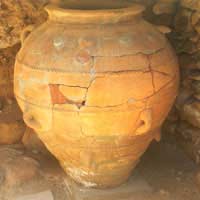
When museums and collectors purchase archaeological items for their collections they enter an expensive and potentially deceptive commercial fine arts arena. Healthy profits are to be made from illicitly plundered ancient sites or selling skillfully made forgeries. Archaeology dating techniques can assure buyers that their item is not a fake by providing scientific reassurance of the artefact’s likely age.
Archaeological scientists have two primary ways of telling the age of artefacts and the sites from which they came: relative dating and absolute dating.
Relative Dating In Archaeology
Relative dating in archaeology presumes the age of an artefact in relation and by comparison, to other objects found in its vicinity. Limits to relative dating are that it cannot provide an accurate year or a specific date of use.
The style of the artefact and its archaeology location stratigraphically are required to arrive at a relative date. For example, if an artefact, say an oil lamp, is found co-located on the same floor of a governor’s dwelling, and that floor can be dated in archaeology terms by reason of the patterns employed in the mosaic, then it is assumed that in relation to the floor that the lamp is of the same age.
Stratigraphy As A Dating Technique
The underlying principle of stratigraphic analysis in archaeology is that of superposition. This term means that older artefacts are usually found below younger items. When an archaeological site is excavated the sides of the unexcavated baulk reveals layering of subsequent settlements and activity. Stratigraphic excavation is the recording and study of these different strata as they are removed from the area.
Style Analysis As An Archaeology Dating Technique
The shape and style of an artefact changes through time although its function may remain the same. The changing styles of pottery, glass, stoneware, and metal objects provide archaeology analysts with known progressive sequences. Once an artefact is compared to its known development date then whenever that item reappears in the archaeological record, of that or any other site, it can quickly be dated.
The Weakness of Relative Dating
The potential flaws in relative dating in archaeology are obvious. Simply assuming that an artefact is older because it was found at a lower depth in the record is only subjective science. There are many instances of deep holes being dug for rubbish pits or to locate well water that protrude into the record of older strata injecting more modern material as they are filled in over time. Landslides and slips can completely change the topography of an entire archaeology site burying what was once on top by that which is much older, hence reversing the strata layers.
Absolute Dating As An Archaeology Dating Technique
A more precise and accurate archaeology dating system is known as absolute dating and can in most circumstances provide a calendar year to the object.
Since 1950 there has been a transformation in the dating techniques of archaeologists. Absolute dating is highly dependant on laboratory analysis. There are a number of techniques that have come to archaeology through the nuclear research efforts during WW2.
Radiocarbon Dating In Archaeology
Radiocarbon dating uses the biological assumption that all living things absorb carbon, both ordinary carbon, C12, and radioactive carbon, C14, into their living tissue. At the moment of death the C14 begins to decay at a rate that scientists already know from other experiments.
The missing amount can then determine how long it took to be lost and therefore date the object to a precise period. C14 Radiocarbon dating can only be used on organic matter.
Uranium – Lead Dating As A Dating Technique In Archaeology
Lithic items cannot be dated by C14 radiocarbon methods but the same principle can be used using radioactive uranium. Rocks, when formed by volcanic reaction or other cataclysmic event, contain a minute quantity of radioactive substance. From the day of the rock’s creation this radioactivity begins to deplete. Like C14, by measuring the loss, a scientist can attribute an age according to known loss rates.
Luminescence Dating In Archaeology
Artefacts that are made from crystalline materials and uncovered in an excavation can be dated using luminescence analysis. Crystalline minerals when subjected to intense heat will burn with differing colours of flame. Mostly used to date pottery in archaeology the method is very effective but costly.
The greatest problem with dating an artefact from an archaeology site is that nearly every absolute dating process requires the destruction of at least a piece of the object in conducting the analysis. There are relatively few dating laboratories and having an artefact dated can be an expensive exercise especially if the artefact is not of great value itself.